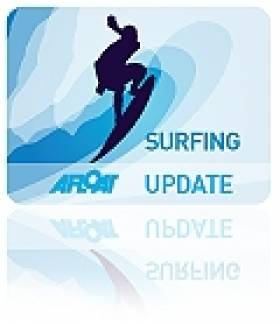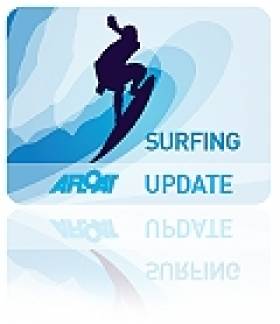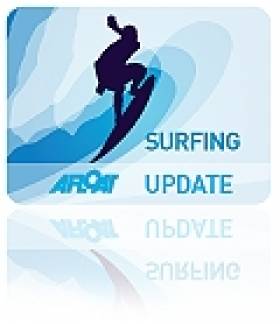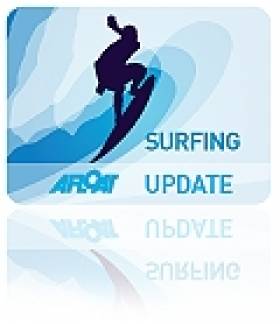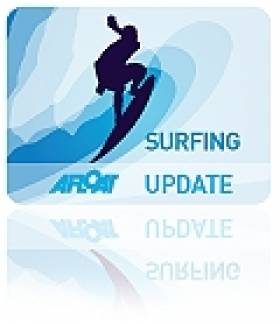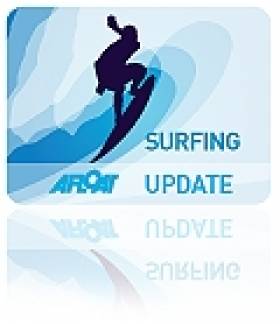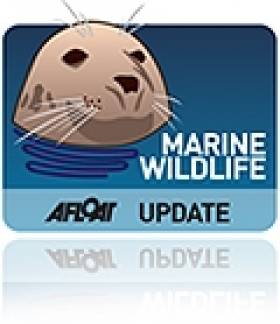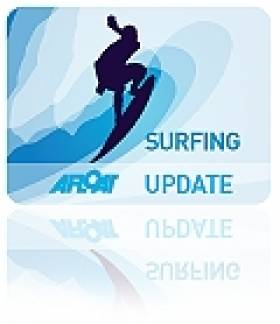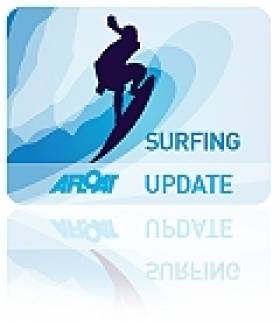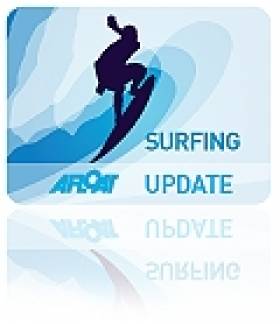Displaying items by tag: Surfing
Surfing Ireland's 'Emerald Slabs' Caught On Video
#Surfing - Check out this stunning video of Portuguese surf pro Nic Von Rupp who cancelled his winter trip to Hawaii last week to take on what Surfer magazine calls 'Ireland's Emerald Slabs'.
Towing out to the storm-fuelled swells of Mullaghmore, Von Rupp shows just how it's done as the world's big wave surfing elite flocked to Sligo for the Billabong Tow-In Session.
Surf Record Breaker Garrett McNamara Rides '100ft Wave'
#Surfing - Garrett McNamara has done it again - after riding what is claimed to be the largest wave ever surfed.
Last summer on Afloat.ie we reported that the Irish-American surfing pro had his previous world record attempt - a 78-foot monster off Portugal in November 2011 - confirmed by Guinness record-keepers.
But the Hawaiian wasn't content to rest on his laurels, and on a recent return visit to Nazaré he is said to have smashed his own record with a wave reported to be as much as 100ft in height.
The Guardian has video of McNamara's incredible attempt which you can view below - it's a sight that beggars belief!
McNamara's previous tow-in surf at Nazaré earned him the Biggest Wave title at the 2012 Billabong XXL Big Wave Awards. He shared his $15,000 prize money with Devon surfer Andrew 'Cotty' Cotton, who towed him by personal watercraft into the massive swell.
"Everything was perfect, the weather, the waves," said Northern Irish surfer Al Mennie, who was on hand to witness the pair at Praia do Norte.
Big Waves Come to Mullaghmore After Long Wait
#Surfing - Some of the world's top big wave surfing talent enjoyed the 'day that almost never was' at Mullaghmore in Sligo on Sunday.
As the video above shows, competitors in the long-delayed Billabong Tow-In Session finally got a chance to prove their mettle after two amber alerts in a week for the international event, pushed back from last year after a calm storm season.
Confidence was high as the storm front that has been battering Ireland for the past two days made its way across the Atlantic, bringing with it the giant swells needed to green-light the action.
Big wave surfers being secretive sorts, due to the dangerous nature of offshore tow-in surfing and their determination to keep their favourite spots 'just for them', we don't yet have results of the action, or even confirmation that the waves were big enough to count!
But what we do know is that the likes of Billabong XXL 2013 Ride of the Year nominee Peter Conroy were present and ready to tackle the colossal walls of water Mother Nature was set to provide.
Meanwhile, Met Eireann warns that gale force winds are expected to continue today (29 January) with southwesterly gusts of up to 110 km/h possible. Those in coastal areas have been warned to exercise caution.
Red Bull Storm Chasers Take off in Kerry
#redbull – The organisers of Red Bull Storm Chasers have scrambled all their crews and teams who had 48hrs to travel from across the globe to Ireland for the first "Mission" on the 3 mission challenge writes Brian Carlin.
Today saw the majority of the country hit with storm force winds. It's results included debris filled roads, heavy traffic, structural damage to buildings and generally unwanted among the most of the country.
Well, not quite the same could be said if you were standing on the back beach in Castlegregory, Co.Kerry locally known as "Dumps" this morning.
It's simple, Red Bull Storm Chase set a 4 month challenge where they require 3 "missions" to be completed. There is 7 possible locations, United States, Iceland, Ireland, Spain, France, Tasmania and Japan.
The conditions seemed just right for the organisers who pulled the trigger Saturday, a logistically nightmare to get the gear, teams, TV crews, helicopters to Ireland.
The first session of the day kicked off in Dumps, Co.Kerry at 7am. A dark morning that quickly brightened by mid-morning. There was a small gathering, massively understated as I read the event is "Windsurfing's Most Challenging Contest". It wasn't long before I understood the attitude, these guys were interested in the sport, they didn't care about hitting news headlines or making the papers, they spoke and were friendly but it was obvious the feeling was focused on the event and nothing else. Serious dedication. In fact I spoke with a competitor who told me his opposition flew in from Maui at 1.30am Monday to Dublin airport. He jumped straight into a car drove through the night. Had his breakfast and showered, then proceeded to suit up for the days challenge.
The crowds did begin to grow and by 12pm about 100 spectators looked on. The winds increased with gusts recorded over 50 knots. As the wind slightly shifted from south west to west south west the organisers decided to move the camp and head to "Hell's Gate". You couldn't build what seemed to be the God's natural Amphitheatre for this event. A little rocky cove that backed onto the North Atlantic, slightly sheltered which made launch and recovery much easier. The cliffs were lined with a variety of young and old, even the local farmers stopped traffic in their tractors to what must have been a rather unusual sight, Red Bull cars and vans, a low flying helicopter and handful of windsurfers who seemed to spend as much time in the air as in the water.
Six sailors now advance to the next mission, where and when? only the weather can decide the time and date.
Surfers On Amber Alert for Third Annual Tow-In Session
#Surfing - Some of the world’s best big wave surfers were last week hurriedly making their way to Ireland to compete in the third annual Billabong Tow-In Session at Mullaghmore in Co Sligo.
Event organisers gave the amber light for the one-day event on the strength of a giant swell that was forecast to reach Mullaghmore this past Monday.
As previously reported on Afloat.ie, the waiting period for the event commenced in November 2012 and finishes on 1 March this year. Organisers only need one day of giant waves to stage the event.
The huge North Atlantic swell headed Ireland’s way looked like providing surf big enough to stage the event but, most importantly, the forecast giant waves were expected to be accompanied by light and favourable winds.
Last year’s event was cancelled because waves in excess of 20 feet in height, with favourable winds, didn’t arrive during the four-month waiting period. But contest director Paul O’Kane said on the current forecasting models it looked like there would be clean and perfect 20-foot waves at Mullaghmore on Monday.
“For a big wave surfing contest such as this that’s about the minimum size we need to run the event,” he said. “But because the ocean conditions will be so clean and perfect on Monday that’s why we have decided to go to amber alert... This will give all the Irish competitors and those coming from overseas enough time to get here and be well organised with their equipment.
For safety reasons the event is restricted to invitees only. Because lives are at stake, only those surfers with recognised big wave experience have been invited to compete. Competitors are also expected to be well versed and qualified in the all necessary rescue and water safety procedures.
Mullaghmore, along with Aileen’s at the Cliffs of Moher in Co Clare, is fast gaining a reputation as one of the most fearsome and challenging big wave locations in the world.
Irish surfers competing in the event are Richie Fitzgerald and Peter Craig (Donegal), Dave Lavelle and Mikee Hamilton (Sligo), Peter Conroy and Ollie O’Flaherty (Clare), Hugh Galloway (Galway) and Al Mennie (Antrim). The international field this year also includes competitors from Ireland, Hawaii, USA, Great Britain, France, Spain, Germany, Tahiti and South Africa.
The event is sanctioned by the Irish Surf Rescue Club and the Irish Surfing Association. Here's hoping we learn soon if the day was a roaring success or a wipeout!
Cold Water Surfers Catch The Waves At Brandon Bay
#Surfing - Check out this beautifully shot video from ONITmedia of intrepid winter surfers catching the breaks at Brandon Bay, Co Kerry.
The waves might not be the biggest that Ireland has to offer at this time of year - for those the wet-suited warriors head to Mullaghmore - but the stunning scenery, not to mention the surprise appearances by local cetaceans, more than make up for it.
Donegal Shark Prank Not So Funny After All
#MarineWildlife - Recent hijinks by a group of Irish surfers in 'shark-infested waters' off Donegal have been making the rounds online - but they're not all what they seem.
IrishCentral reports on the video, apparently posted by surfers from Rossnowlagh, which shows the group on a RIB pushing one of their own overboard into the path of an oncoming shark.
Yet despite their reactions, they were never in any danger, as the shark was one of Ireland's harmless giants - a basking shark - who clearly attempts to dodge the dinghy as it approaches.
Indeed, the shark may even have been in more danger from the surfers than they were from it, as the marine species is designated as protected under EU law, which makes it illegal to disturb or harass them.
As reported on Afloat.ie earlier this year, the UK's Shark Trust has published a code of conduct for anyone encountering basking sharks in British or Irish waters - and pushing someone overboard on top of one is definitely absent from the list.
Dashing Through the Surf On a No-Horse Open Wave!
#SURFING - Here's a little something festive with four weeks to go till Christmas, as Afloat alum Markham Nolan highlights this wonderful photo of Santa Claus riding the waves on a stand-up paddle board via surfing website Magicseaweed.
The shot was captured by Rich Murphy over the weekend in Dublin, and not only shows Santa getting to trips with a new form of transport - but that even the east coast of Ireland has its fair share of quality swells.
Ballinspittle a Popular Haunt for Surfing Crowd
#SURFING - The Irish Examiner reports on the "little economic miracle" that is Ballinspittle in Co Cork, a village that's "bucking the national economic trend" via its plethora of local businesses - and its close proximity to quality surf.
The village has "witnessed a inflict of Australians and South Africans" among others "in search of a surfing haunt", thanks to the nearby Blue Flag beaches at Garrettstown and Garrylucas.
John Hynes, who runs the surfing school GTown Surf, says Cork's coast is "one of the most consistent stretches in the south" that's "perfect for budding surfers. So, there's no excuse for not getting out there and enjoying the waves."
The Irish Examiner has more on the story HERE.
Surfer Al Mennie Rides a 50ft Wave - As seen By a Go Pro Camera
#surfing – Surf regular on Afloat's homepage Al Mennie from Coleraine is back on the water again. Although from the angle we're watching this 50-foot waves does not look that impressive it's very clear from Mennie's reaction just how big this spot in Portugal actually was.


























